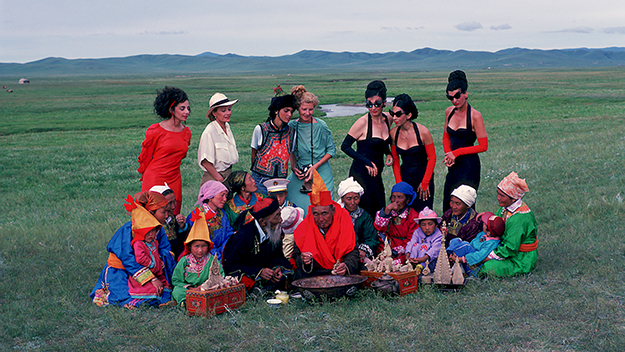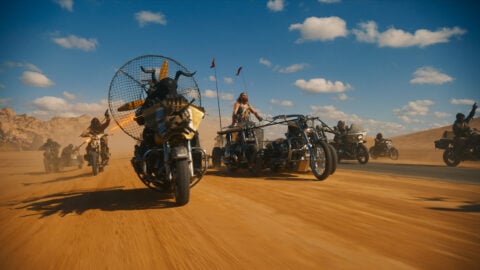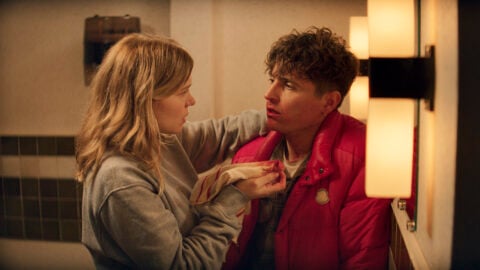Interview: Ulrike Ottinger
This article appeared in the February 9, 2023 edition of The Film Comment Letter, our free weekly newsletter featuring original film criticism and writing. Sign up for the Letter here.

Joan of Arc of Mongolia (Ulrike Ottinger, 1989)
A key figure in the New German Cinema, Ulrike Ottinger has written, directed, and photographed approximately 25 features and shorts. Born in Germany in 1942, she moved to Paris in the 1960s to study art. Returning to Germany, she made her first film, Laocoön & Sons, between 1972 and ’73. Her early titles explored Berlin using both fiction and documentary modes, while later works opened up her views on feminism and politics. Freak Orlando (1981) freely adapts Virginia Woolf’s novel Orlando into a gender-fluid fantasia. In Joan of Arc of Mongolia (1989), a group of cosmopolitan women, one played by Delphine Seyrig, are kidnapped by Mongol warriors while taking the Trans-Siberian Railway, which open up an inquiry into cross-cultural conflicts. The Korean Wedding Chest (2009) finds surrealism in marriage rituals past and present.
Breaking rules comes easily to Ottinger, whose style combines striking costumes and locations with idiosyncratic camerawork and complex soundtracks. A commission for a 90-minute film might spawn a 12-hour documentary. Her plots might splinter apart, characters might shift genders, genres may dissolve. Constant to her work is an inexhaustible curiosity, evident whether she is documenting an experimental art “happening” in Berlinfever – Wolf Vostell (1973); exploring urban life in Beijing, Sichuan, and Yunnan in China. The Arts – The People (1985); or depicting an amusement park in Vienna in Prater (2007).
This year the EnergaCAMERIMAGE International Festival of Cinematography gave Ottinger its Award for Avant-Garde Achievements in Film; as part of the honor, Ottinger was invited to present some of her notable works. I spoke with the filmmaker after a screening of 1979’s Ticket of No Return, a slippery, absurdist film about a woman who traipses through Berlin, drinking herself into oblivion. Ottinger chose to screen three other titles that represent her interest in documentary, Asian art, and collage: Prater, Under Snow (2011), and Paris Calligrammes (2019).
How has your experience been at CAMERIMAGE?
I’m here in Toruń for the first time. What I find fascinating is that when you go to a festival in Poland, it’s not only film people who attend. It’s also artists, intellectuals, a wonderful community that I appreciate a lot. Interesting people in different fields.
You don’t follow the rules of narrative filmmaking the way other artists do.
I never have. I don’t do it to go against something; it’s just a way I found that’s right for me. It was never a provocation—I just wanted to do things a certain way.
I think a lot about how to work. Sometimes I’m very prepared, but sometimes I have a spontaneous idea that I can’t refuse. You have to interact with your surroundings. For example, I did a documentary about nomads in Mongolia [Taiga (1992)] where I shot the landscape, the people, what they were doing. Each shot was like a little story in itself.
On the other hand, for Paris Calligrammes, my latest film, I did research by screening five or six hundred films. I went to theater archives, newspaper archives, private archives. I researched all the things that were important to me and my friends in the late 1960s in Paris. We shot new material, but the film itself was mostly collage. So I think for each project you have to find the right form. The avant-garde is always where you don’t think she should be.
What inspires you to start a film?
First, I think it’s good to see many things. Sometimes you start with very simple things: observations you make on the street, conversations you hear. Anything can be a starting point.
I think you should never do what is expected. It’s important that you feel that this is the way you should do it. And if it isn’t good, that’s not a catastrophe, it’s a beginning.
You’ve said that locations are protagonists.
When I arrived in Berlin in 1973, after living in Paris, I was amazed to see a city that was gray, not glamorous at all. But it was highly interesting. You could see the entire history of Germany in it. When you are making a film, this is exactly what you are looking for: the secret that is visible. You have to see, but also interpret.
Do you approach your documentaries like Southeast Passage (2002) and Taiga in the same way?
You don’t go as an inquisitor, saying, “Why are you doing this? Why are you doing that?” When I went to Mongolia, I showed people volumes, big bibles of research. Photographs, drawings, photocopies, postcards, all kinds of visual material. They recognized objects and commented on them. We had tea, we had fun together—we were singing, laughing. That creates an atmosphere where you can film.
I’ve shot in marketplaces in about 20 or 25 different countries. They are always places where people, and culture, are concentrated. When I was filming in the fish market in Odessa for Southeast Passage, for example, there were all women, really strong women who can give back. You can’t hide behind a column to film them; you have to go to them and say, “That looks so fantastic.” That starts a dialogue, an interaction. Then they are not an “object” or “subject.” Instead, it’s a kind of funny conspiracy between us.
So you don’t have an agenda?
Of course I have ideas, but they can change completely. It doesn’t make any sense to do a documentary if you know everything beforehand.
How can you be sure you’re reading a culture correctly?
There are always mistakes, but with time you have more experience. Claude Lévi-Strauss would say, “I’m not a specialist in Japan,” but what he saw during the four weeks he traveled there, people who had been there for years still didn’t understand. It’s not only what you know, but how you look at things.
Many of your films have Asian settings.
I’ve always found stylized forms in Asia interesting. I’ve studied different Asian dramaturgies. They are not influenced by our religions, like Christianity. They have another approach to transformation. For them, art should show the essence of things, because the “thing” itself is in front of you.
I’ll give you the example of an ink painting. When you take ink with water to paint, it’s a natural process that you can see and understand. But at the same time, the nature of the ink and water becomes something different. They are no longer two elements but a third. They combine and transform to become art. I’ve been thinking about this for a long time. I always want to get to that point in my films, where elements transform into something else.
I’d love to watch you pitch that to funders.
When you apply for money for a documentary, they want a script of 100 to 150 pages. Can you imagine?
Agnès Varda told me a story about going to Canal+ to meet with the funding committee. It was autumn, and on the way she found a wonderful leaf, red and yellow. She put it on the table before the Canal+ people and said, “I’d like to do a film about this.”
I would love to behave that way, but I would never get money after a presentation like that. So instead, you have to pretend to know everything.
For Chamisso’s Shadow [2016], I received some money from a German media cooperative fund set up for film and television. They agreed to buy it and show it two years later on TV. I got a grant for a 90-minute film and went off to the Bering Sea to shoot. When I came back to edit, they called after about three months and asked, “Can we come see something?” I said, “No, not yet.” After five months I called and said they could come now, the film was almost finished. They said, “Great, we’ll come tomorrow after we attend another screening in the morning.” I said, “No, you have to come for two days.” [Chamisso’s Shadow has a 12-hour runtime.]
Can you imagine telling them that? It was dangerous. They could have taken away the money. We fought over it for months.
How was it resolved?
They eventually showed the first part of the film on television, and I got more money. But you have to fight. It’s really risky.
I have gotten some peculiar offers. I made a documentary in Sichuan in 1985 [China. The Arts – The People]. There’s a scene with thousands of bicycles circling around, and in the background you hear this insistent car horn. People from Volkswagen approached me and said, “Wouldn’t it be fantastic if in the middle of all these bicycles one of our cars would appear?” I think it was because they were about to build their first factory there.
Maybe I should have done it. They have so much money that I could have visited China again, but I was already on my way to something else.
In Ticket of No Return, there’s a scene where Tabea Blumenschein leaves her hotel wearing a black evening gown, and she signals for a taxi. I got a call from a taxi company who wanted to use it for a commercial.
What was your collaboration with Blumenschein in Ticket of No Return like? She was the costume designer as well as the main performer.
She wore those high stilettos in that film. The sound of her walking in them became a kind of leitmotif—that and the sound of breaking glass.
Tabea wasn’t really an actress. She spoke in dialect at the time—she didn’t speak Hochdeutsch [High German]—so I thought it would be fantastic if she came as a foreigner to a city where she doesn’t speak the language.
You had to arrange everything for Tabea, but it worked. At that time, she was my partner. We lived together in this wonderful, big apartment. It was a strange situation in Berlin then: there were stores filled with luxury goods, but no customers. You could buy fabric, feathers, pearls for making hats or dresses. We arranged them all on a big table, and then Tabea went to work. She was fantastic—she could make these perfect cuts.
She died suddenly two and a half years ago. It was a wonderful collaboration, full of ideas and fantasies.
Daniel Eagan is a writer and producer based in New York City.







